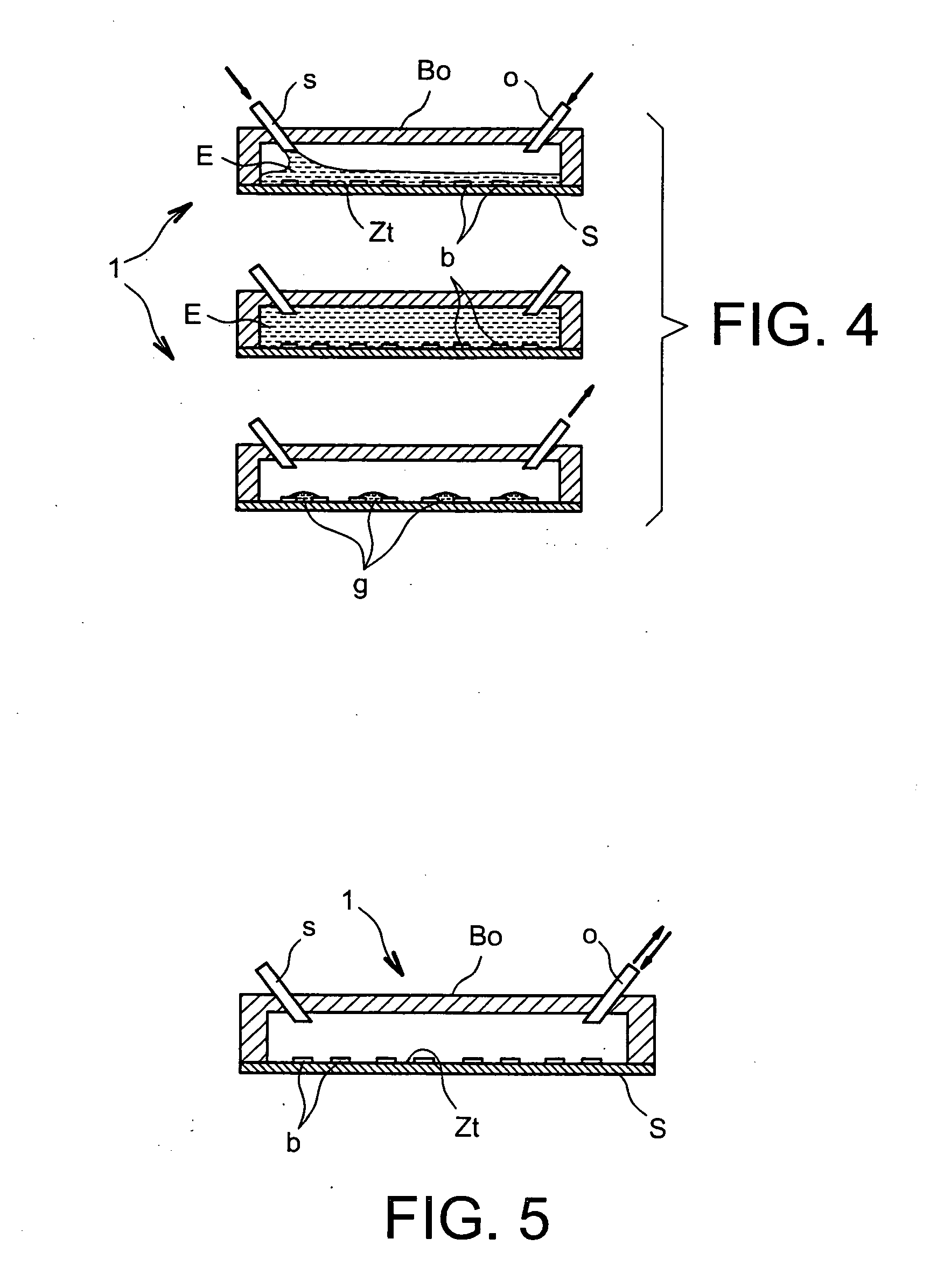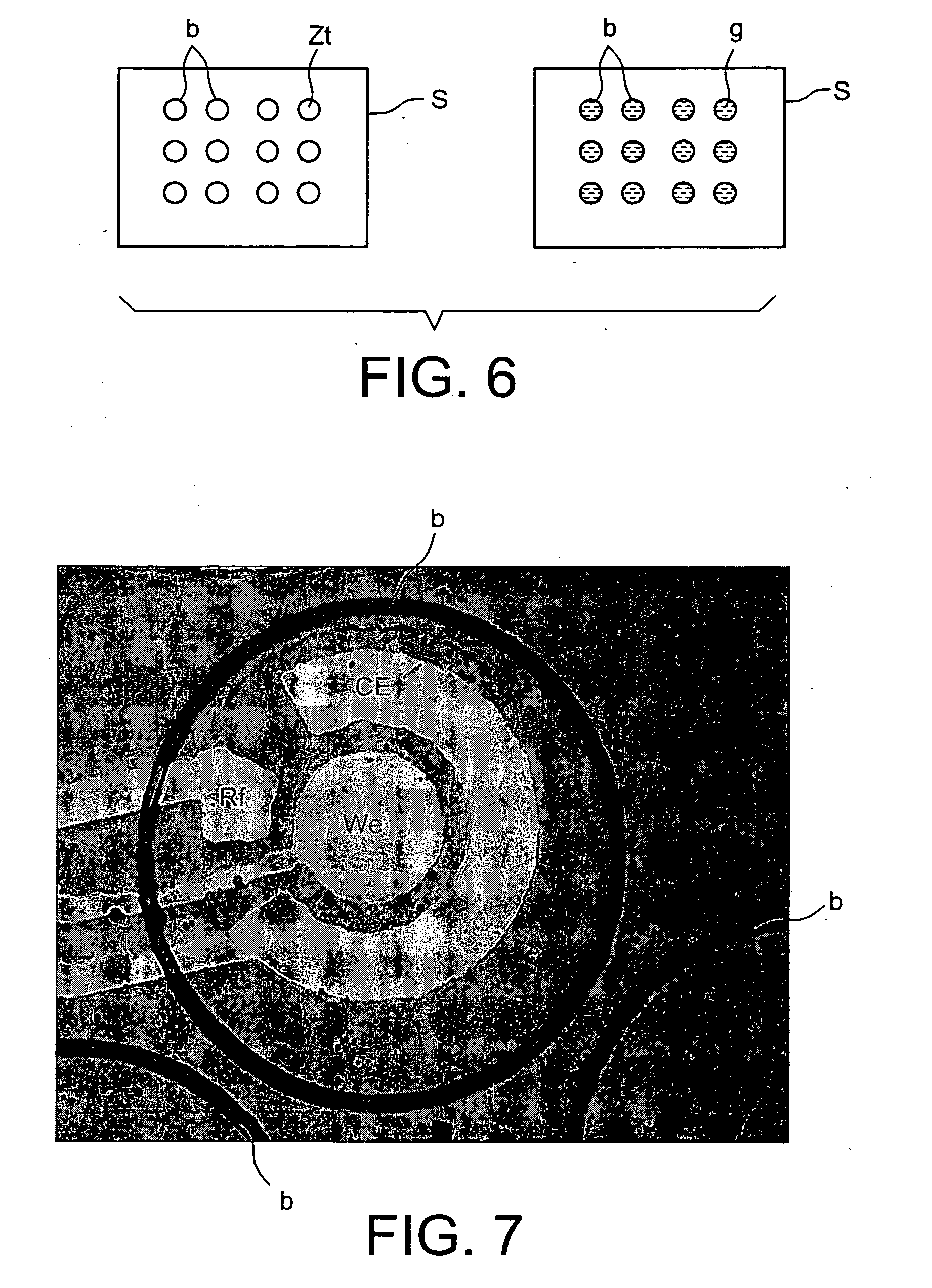Work device comprising bordered work zones, on-chip laboratory and microsystem
- Summary
- Abstract
- Description
- Claims
- Application Information
AI Technical Summary
Benefits of technology
Problems solved by technology
Method used
Image
Examples
example 1
Production of Capture Zones Formed from Borders
[0123] A photolithography step is carried out on a fresh silicon wafer with a Clariant AZ4562 (trade name) thick photoresist as follows: [0124] deposition of an adhesion promoter, which is hexamethylenedisilazane here, in an oven at 120° C., [0125] spin-coating of resin at 1000 rpm for 30 seconds with an acceleration of 200 rpm / s, [0126] annealing on hotplate at 115° C. for 2 minutes, [0127] insolation on Karl Süss MA750 (trade name) exposure machine for 50 seconds in batch mode (5×10 seconds with 5 seconds pause) through a mask, [0128] development in a Shipley MF319 (trade name) solution diluted in proportions of 1:3 with deionized water, [0129] cleaning with deionized water and drying under nitrogen stream, [0130] annealing on a hotplate at 115° C. for 3 minutes, then at 150° C. for 1 minute, [0131] thickness measurement: 13 μm.
[0132] On the mask used for insolation, all the motifs represent rings of which the walls have a width of ...
example 2
Production of the Box
[0134] A hollow cover of polydimethylsiloxane (PDMS) is produced by moulding on a glass mould with a square pattern and an oventhickness of 1 mm. On a plane device like those obtained with the preceding example, this hollow cover is fixed hermetically by bonding with crosslinking adhesive by irradiation with ultraviolet radiation (VITRALIT 6181). The connections for the fluid inlets and outlets are made by drilling the cover with small-diameter needles. The inlet needle is connected to fluid transport tubes and to a syringe filled with liquid of interest. The final assembly is tested for leaks, in the knowledge that the liquid must only pass through the connections provided for this purpose.
[0135]FIG. 4 is a schematic representation of the box obtained in this example. Other arrangements of the inlet and outlet connections (o, s) for introducing and extracting a liquid of interest can easily be obtained according to this example, and FIG. 9 schematically shows...
example 3
Capture of Deionized Water on a Silicon Surface with Native Oxide
[0137] Various types of features forming borders according to the invention, shown in FIGS. 1 to 3 appended hereto, and obtained by the method described in example 1, are tested with deionized water (DW).
[0138] For this purpose, covers with a fluid stream about 1 mm thick created thanks to a work box according to the invention, produced according to example 2 (FIG. 4 appendedhereto) are used for the injection and extraction of DW, via plastic tubes.
[0139] The initial surface, consisting of silicon with a coat of native oxide, was not treated and the contact angle was close to 68° with the DW.
[0140] As shown in FIG. 6 appended hereto, to the right, the DW remains retained in the depressions formed by the border (b), on the work zone (Zt), in the form of drops (g) after removal of the liquid of interest by suction.
[0141] Various methods for filling the box with the liquid of interest were tested: with the introducti...
PUM
 Login to View More
Login to View More Abstract
Description
Claims
Application Information
 Login to View More
Login to View More - R&D
- Intellectual Property
- Life Sciences
- Materials
- Tech Scout
- Unparalleled Data Quality
- Higher Quality Content
- 60% Fewer Hallucinations
Browse by: Latest US Patents, China's latest patents, Technical Efficacy Thesaurus, Application Domain, Technology Topic, Popular Technical Reports.
© 2025 PatSnap. All rights reserved.Legal|Privacy policy|Modern Slavery Act Transparency Statement|Sitemap|About US| Contact US: help@patsnap.com



